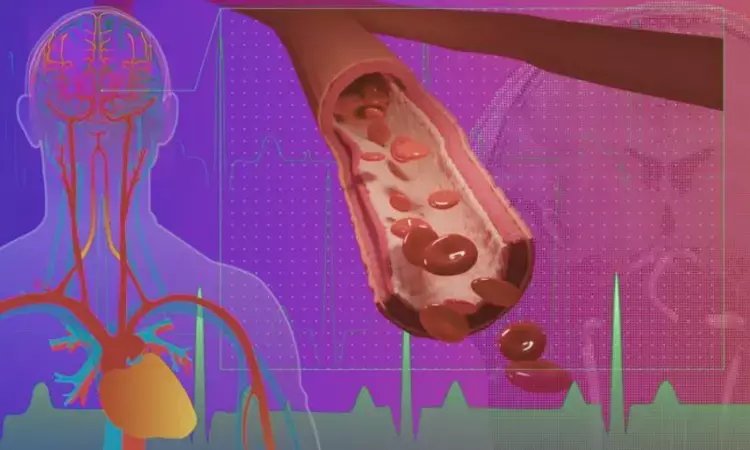- Home
- Medical news & Guidelines
- Anesthesiology
- Cardiology and CTVS
- Critical Care
- Dentistry
- Dermatology
- Diabetes and Endocrinology
- ENT
- Gastroenterology
- Medicine
- Nephrology
- Neurology
- Obstretics-Gynaecology
- Oncology
- Ophthalmology
- Orthopaedics
- Pediatrics-Neonatology
- Psychiatry
- Pulmonology
- Radiology
- Surgery
- Urology
- Laboratory Medicine
- Diet
- Nursing
- Paramedical
- Physiotherapy
- Health news
- Fact Check
- Bone Health Fact Check
- Brain Health Fact Check
- Cancer Related Fact Check
- Child Care Fact Check
- Dental and oral health fact check
- Diabetes and metabolic health fact check
- Diet and Nutrition Fact Check
- Eye and ENT Care Fact Check
- Fitness fact check
- Gut health fact check
- Heart health fact check
- Kidney health fact check
- Medical education fact check
- Men's health fact check
- Respiratory fact check
- Skin and hair care fact check
- Vaccine and Immunization fact check
- Women's health fact check
- AYUSH
- State News
- Andaman and Nicobar Islands
- Andhra Pradesh
- Arunachal Pradesh
- Assam
- Bihar
- Chandigarh
- Chattisgarh
- Dadra and Nagar Haveli
- Daman and Diu
- Delhi
- Goa
- Gujarat
- Haryana
- Himachal Pradesh
- Jammu & Kashmir
- Jharkhand
- Karnataka
- Kerala
- Ladakh
- Lakshadweep
- Madhya Pradesh
- Maharashtra
- Manipur
- Meghalaya
- Mizoram
- Nagaland
- Odisha
- Puducherry
- Punjab
- Rajasthan
- Sikkim
- Tamil Nadu
- Telangana
- Tripura
- Uttar Pradesh
- Uttrakhand
- West Bengal
- Medical Education
- Industry
High-Resolution 7-Tesla MRI Reveals Brain Microvessel Pulsations Linked to Aging: Study

USA: A novel brain imaging approach using ultra-high field 7-tesla MRI has enabled researchers to noninvasively observe how tiny blood vessels in the brain pulse with each heartbeat, offering new insights into aging and neurodegenerative diseases such as Alzheimer’s.
The study, published in Nature Cardiovascular Research, revealed that microvascular pulsations—referred to as microvascular volumetric pulsatility—are amplified in the brain’s deep white matter with advancing age, and these changes are further intensified in individuals with hypertension. These findings suggest that monitoring such pulsations could improve understanding of cerebral small vessel health and its role in cognitive decline.
The research was led by Fanhua Guo from the Laboratory of FMRI Technology (LOFT), Mark & Mary Stevens Neuroimaging and Informatics Institute, Keck School of Medicine, University of Southern California (USC), Los Angeles, along with senior author Danny JJ Wang, PhD. The team combined two advanced imaging techniques—arterial spin labeling (ASL) and four-dimensional vascular space occupancy (4D VASO)—to track subtle volumetric changes in the brain’s microvessels over the cardiac cycle.
The study included 12 older adults with a median age of 60 and 11 younger participants with a median age of 28, allowing the researchers to compare age-related differences in microvascular pulsatility.
Historically, while the relationship between large artery stiffness and risks of stroke, dementia, and small vessel disease has been well documented, assessing pulsations in the brain’s smallest vessels has been challenging. Prior studies were often limited to animal models or invasive procedures, making fine-grained observation in humans difficult. The combination of ASL and 4D VASO in this study overcomes these barriers, enabling high-resolution, in vivo measurement of microvascular pulsatility without invasive methods.
The results showed the following findings:
- Older adults showed significantly higher microvascular pulsatility in deep white matter regions compared to younger individuals.
- Hypertension further amplified microvascular pulsatility in deep white matter.
- The microvascular volumetric pulsatility index (mvPI) in deep white matter correlated with large artery velocity pulsatility, linking micro- and macrovascular function.
- The imaging method demonstrated strong reproducibility and accuracy through test–retest scans and non-parametric reliability testing.
- This non-invasive approach enables detailed examination of how aging affects cerebral microvascular health.
- It allows precise mapping of microvessel pulsatility across cortical layers and white matter.
- The technique may help detect early vascular changes contributing to neurodegenerative disorders, including Alzheimer’s disease.
- The method has potential implications for understanding glymphatic function, neurodegeneration, and cognitive decline.
The study highlights the value of high-resolution, 7-tesla MRI combined with advanced ASL and 4D VASO techniques in advancing our understanding of cerebral microvascular physiology.
"As research in this area continues, such imaging tools may help guide interventions to preserve vascular health and cognitive function in aging populations, potentially transforming how clinicians monitor and manage neurovascular risk in older adults," the authors concluded.
Reference:
Guo, F., Zhao, C., Shou, Q., Jin, N., Jann, K., Shao, X., & Wang, D. J. (2025). Assessing cerebral microvascular volumetric with high-resolution 4D cerebral blood volume MRI at 7 T. Nature Cardiovascular Research, 1-15. https://doi.org/10.1038/s44161-025-00722-1
Dr Kamal Kant Kohli-MBBS, DTCD- a chest specialist with more than 30 years of practice and a flair for writing clinical articles, Dr Kamal Kant Kohli joined Medical Dialogues as a Chief Editor of Medical News. Besides writing articles, as an editor, he proofreads and verifies all the medical content published on Medical Dialogues including those coming from journals, studies,medical conferences,guidelines etc. Email: drkohli@medicaldialogues.in. Contact no. 011-43720751
Next Story


